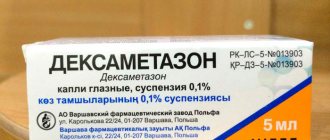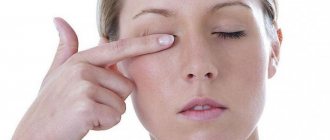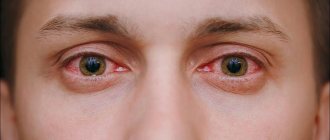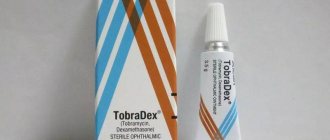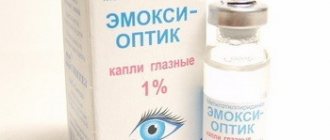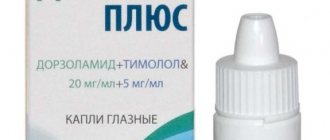Pharmacodynamics and pharmacokinetics
Dexamethasone by its nature is a glucocorticosteroid (GCS) that does not have mineralocorticoid activity, but can have a pronounced anti-inflammatory and antiallergic effect, prevent or weaken allergic reactions (desensitizing effect). Active suppression of inflammatory processes occurs due to inhibition of the release of inflammatory mediators by eosinophils, as well as the migration of mast cells, which reduces capillary permeability.
Possible adverse reactions
The medication also has serious side effects. They usually relate to visual acuity. After instillation, the patient may experience blurred vision, which, however, goes away after 5-10 minutes.
Visual acuity may decrease during the entire treatment period, which is due to the effects of the components. What other adverse reactions from the use of Maxidex drops are noted by ophthalmologists:
- Allergic reaction.
- Slow healing of wounds on the cornea.
- Increased intraocular pressure.
- Possible damage to the optic nerve.
- If the drug is actively used together with other anti-inflammatory drugs, a secondary infection may occur.
The manufacturer has not reported any cases of overdose. However, when used for longer than a month, the risk of frequent fungal infection increases.
In what cases should you resort to Lasik eye surgery, find out here.
Increased intraocular pressure increases the risk of developing glaucoma
A reliable remedy for combating bacterial conjunctivitis is Levomycetin eye drops.
Side effects
Long-term use of steroid drugs can cause an increase in intraocular pressure (IOP) , as well as the future development of glaucoma . As a result, it is possible to develop characteristic lesions of the optic nerve, the development of posterior subcapsular cataracts , and changes in visual fields. Therefore, it is recommended to regularly measure IOP when using the drug for more than 10 days. In addition, diseases leading to thinning of the cornea and sclera, perforation of the fibrous membrane as a side effect, cause a slowdown in the wound healing process.
Fungal infections of the cornea may occur, especially with long-term use of steroid drugs. If non-healing ulcers appear on the cornea after a long course of treatment with steroids, this may be evidence of the development of fungal invasion .
Description of the drug MAXIDEX
Caution should be used in case of parasitic and infectious diseases of a viral, fungal or bacterial nature (currently or recently suffered, including recent contact with a patient) - herpes simplex, herpes zoster (viremic phase), chicken pox, measles, amoebiasis, strongyloidiasis (established or suspected), systemic mycosis; active and latent tuberculosis. Use for severe infectious diseases is permissible only against the background of specific therapy.
It should be used with caution within 8 weeks before and 2 weeks after vaccination, with lymphadenitis after BCG vaccination, with immunodeficiency conditions (including AIDS or HIV infection).
The following should be used with caution for gastrointestinal diseases:
- peptic ulcer of the stomach and duodenum, esophagitis, gastritis, acute or latent peptic ulcer, recently created intestinal anastomosis, ulcerative colitis with the threat of perforation or abscess formation, diverticulitis.
Should be used with caution for diseases of the cardiovascular system, incl. after a recent myocardial infarction (in patients with acute and subacute myocardial infarction, the necrotic focus may spread, slowing down the formation of scar tissue and, as a result, rupture of the heart muscle), with decompensated chronic heart failure, arterial hypertension, hyperlipidemia), with endocrine diseases - diabetes mellitus ( including impaired tolerance to carbohydrates), thyrotoxicosis, hypothyroidism, Itsenko-Cushing's disease, with severe chronic renal and/or liver failure, nephrourolithiasis, with hypoalbuminemia and conditions predisposing to its occurrence, with systemic osteoporosis, myasthenia gravis, acute psychosis , obesity (III-IV degree), with poliomyelitis (with the exception of the form of bulbar encephalitis), open- and closed-angle glaucoma.
If intra-articular administration is necessary, it should be used with caution in patients with a general severe condition, ineffectiveness (or short duration) of the action of 2 previous administrations (taking into account the individual properties of the GCS used).
Before and during GCS therapy, it is necessary to monitor a general blood count, glycemic levels and plasma electrolyte levels.
For intercurrent infections, septic conditions and tuberculosis, simultaneous antibiotic therapy is necessary.
Relative adrenal insufficiency caused by dexamethasone may persist for several months after its discontinuation. Taking this into account, in stressful situations that arise during this period, hormonal therapy is resumed with the simultaneous administration of salts and/or mineralocorticoids.
When using dexamethasone in patients with corneal herpes, the possibility of corneal perforation should be kept in mind. During treatment, it is necessary to monitor intraocular pressure and the condition of the cornea.
With the sudden withdrawal of dexamethasone, especially in the case of previous use in high doses, a so-called withdrawal syndrome occurs (not caused by hypocortisolism), manifested by anorexia, nausea, lethargy, generalized musculoskeletal pain, and general weakness. After discontinuation of dexamethasone, relative adrenal insufficiency may persist for several months. If stressful situations arise during this period, GCS is prescribed (according to indications), if necessary in combination with mineralocorticoids.
During the treatment period, monitoring of blood pressure, water and electrolyte balance, peripheral blood picture and glycemic level, as well as observation by an ophthalmologist is required.
In children, during long-term treatment, careful monitoring of the dynamics of growth and development is necessary. Children who during the treatment period were in contact with patients with measles or chickenpox are prescribed specific immunoglobulins prophylactically.
Instructions for use of Maxidex (Method and dosage)
Instructions for Maxidex eye drops: instill 1-2 drops into the conjunctival sac every 3-6 hours or as prescribed by your doctor.
For eye ointment: place a 1–1.5 cm strip of ointment behind the lower eyelid, repeat up to 3 times a day. It is correct to combine ointment and eye drops, using the ointment before bedtime and the eye drops several times during the day.
Do not use the drug for injection. To avoid introducing bacteria into the vial when using drops, do not touch the dropper to any surfaces. It is not recommended to wear contact lenses during treatment with Maxidex. Shake the bottle before each use.
Reviews about the application
Review by Dmitry, 58 years old:
“I suffered from itching and discomfort in my eyes for a long time. It was hard to read and watch TV, and after trips to the dacha it became completely unbearable. When I consulted an ophthalmologist, he diagnosed chronic blepharitis. He said that the disease is poorly treated and often recurs. Prescribed Tobrex and Maxidex ointment. After the course of treatment, everything went away. Now I feel great, there were no complications.”
Review from Natalia (33 years old):
“I have been using drops for two years, and for this reason: I often suffer from redness of the eyes, pain and pain in them when wearing lenses. It sometimes hurts so much that I simply can’t open my eyes, it hurts to look at the light. And so Maxidex for me is a kind of lifesaver that helps to eliminate inflammation in the eyes and cope with pain in the shortest possible time. And the medicine is inexpensive and lasts me a long time. But before using it, I still advise you to consult with your ophthalmologist. As the instructions for use say, the medicine has its contraindications! I consulted in my situation, and the doctor approved.”
Review from Daria, mother of two-year-old Dina:
“We were prescribed Maxidex for the treatment of allergic conjunctivitis. My daughter tolerated the therapy well and quickly felt better. We are satisfied with the drug. Later we completed a course of specific hyposensitization, and now the allergy does not bother us at all.”
Review from Irina (45 years old):
“I have tender and sensitive eyes, which often become inflamed from strong winds or working in the garden. I tried using different drops for inflammation, but often there was no effect. Therefore, for me, Maxidex products became a real godsend - the doctor, knowing my problem, advised me to use ointment and drops in combination. As soon as I noticed signs of inflammation, I drop it every 2 hours (dosage - 1 drop), then 3 times a day, and apply the ointment every day at night. So I’m treated for 3-5 days and everything goes away!”
Feedback from Evgeniya Aleksandrovna Kulikina, a pediatric ophthalmologist with 20 years of experience:
“For me, Maxidex is another corticosteroid-based drug. There are many similar products on the market. They have different prices and quality. Maxidex is produced by the proven pharmacological company Alcon, well known for its quality drugs. Therefore, I prescribe their products to patients without fear.
The instructions for use do not contain data on the use of the medicine in childhood. However, I prescribe all corticosteroids to children when the expected therapeutic effect outweighs the risk of complications. If a child has severe allergic conjunctivitis, I immediately prescribe antihistamines and corticosteroids. I’m sure it’s better to give the baby the necessary medications right away than to risk his health.”
The drug will help with long-term inflammatory process.
Feedback from Natalya Aleksandrovna (ophthalmologist with 15 years of experience):
“In my practice, I use Maxidex drops and ointment. I prescribe them to patients with long-term inflammatory processes of the conjunctiva and cornea of the eyes, as well as if it is necessary to quickly relieve allergic manifestations. In the first case, the approximate treatment regimen will be 1 drop 3 - 4 times a day and put the ointment behind the lower eyelid at night, in the second, 1 - 2 drops every 1.5 - 2 hours (the ointment may not be used). I select the course and scheme individually in each specific case. I definitely don’t recommend self-medication with regard to hormonal drugs to anyone!”
Reviews
Patients who have used Maxidex eye drops say that it is a very powerful remedy that effectively relieves almost any inflammation of the eye, however, daily use is undesirable due to the development of adverse reactions as a result of long-term treatment.
Among the positive reviews are the following:
- “... Helps, the eyes become clean, removes swelling and puffiness”;
- “... Can be used for allergies, relieves tearing.”
In general, the drug is praised and recommended.
Indications for use of Maxidex eye drops
Maxidex eye drops are used to treat a whole range of serious diseases. In what cases are they used especially often:
- Allergic or non-purulent conjunctivitis.
- Blepharitis.
- Iridocyclitis, scleritis.
- A thermal or chemical burn to the eye.
- Treatment of inflammation that occurs after surgery.
Each case is individual, and therefore an ophthalmologist must make a diagnosis and prescribe medications. Thanks to its composition, the drug "Maxidex" quickly acts on the source of inflammation, eliminates it, significantly improving well-being within 1-3 days after the start of use.
Maxidex eye drops are sometimes used as an adjuvant drug for the treatment of glaucoma and ocular tuberculosis. The composition can also be used for serious purulent infections in combination with antibiotics.
Why a person can see poorly at dusk - the symptoms of night blindness are described in the article.
The drug is ideal for relieving allergic edema
In what situations is the use of L Optik eye drops indicated here?
Maxidex price, where to buy
The average price of Maxidex eye drops 0.1% (5 ml bottle) is 350 rubles.
- Online pharmacies in RussiaRussia
- Online pharmacies in UkraineUkraine
- Online pharmacies in KazakhstanKazakhstan
ZdravCity
- Maxidex eye drops 0.1% 5mlS.A.
Alcon-Couvreur nv RUR 306 order
Pharmacy Dialogue
- Maxidex (vial 0.1% 5ml)Alcon
330 rub. order
show more
Pharmacy24
- Maxidex 5 ml drops Alkon-Cuvrior, Belgium
93 UAH. order
PaniPharmacy
- Maxidex liquid Maxidex h/c 0.1% 5ml Belgium, Alcon-Couvreur
95 UAH order
show more
Indications for treatment
Appearance of Maxidex eye drops
Maxidex is a medicine that has anti-allergenic and anti-inflammatory properties. Reduces the body's increased sensitivity to foreign, administered protein. Destroys viruses, eliminates inflammation in tissues, stops the growth of pathogenic bacteria. The drug is recommended for:
- inflammation of the eyes – uveitis, cyclitis, scleritis;
- conjunctivitis – catarrhal, seasonal, allergic;
- keratoconjunctivitis;
- chemical burns, eye injuries;
- recovery after operations;
- otitis.
Sometimes drops are used in combination with medications that treat trachoma, glaucoma, and fungal diseases.
Composition and release form
The product is available in plastic bottles with a 5 ml dropper. In this case, the bottle is placed in a cardboard package, which also contains instructions for use.
Maxidex drops are a transparent liquid without unnecessary impurities that should not spread. Typically the composition has a viscous consistency.
The main active ingredient is dexamethasone. Its concentration per 1 ml is 1 mg.
In addition, the composition found a place for hydroxypropyl methylcellulose, benzalkonium chloride and purified water.
Despite their simple composition, the drops are considered extremely effective. The active substance acts on the source of inflammation, allowing it to be quickly eliminated.
The medicine is indispensable for use during the recovery period after surgery
If bacterial conjunctivitis is diagnosed and Levofloxacin is prescribed, it would be wise to first read the instructions for use of Levofloxacin eye drops here.
